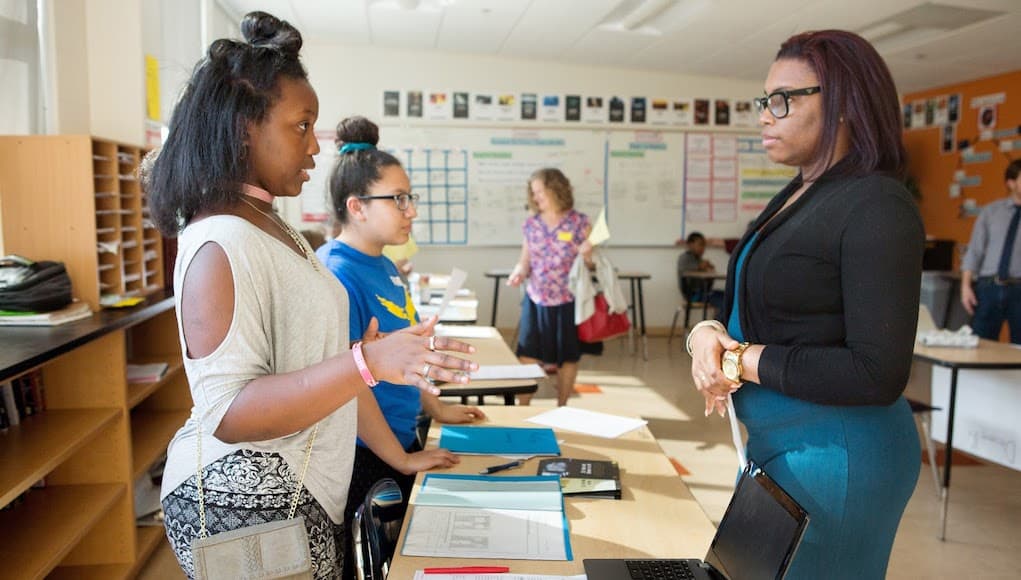5 Ways Face-to-Face Learning Will Need to Differentiate to Contrast Virtual Learning

The school closures this spring, along with the national efforts to deliver instruction online, has certainly challenged all stakeholders. There have been successes: implementing new technologies, a renewed focus on instructional and social-emotional priorities, creative lessons/projects, and increased parent engagement. Naturally, there have been potential pitfalls: technology access inequities, delivery of additional services such as food and healthcare, and potential loss or delay in key literacy and skills acquisition.
It seems safe to say that most educators, students, and families will be happy if they do indeed return to school in the fall. That being said, we have experienced something that I have queried for a long time. What would it be like if students—especially at the secondary level—chose what is and has been available to them all for quite some time? And that is attending school completely online.
For our secondary learners, I have long argued that much of their interest and engagement in continuing to attend school in face-to-face environments has been the connection to co-curricular and extra-curricular activities, teams, performing groups, and social opportunities. And now that they have experienced distance or virtual learning full-time and could choose to continue to do that anytime, what will keep them coming to school beyond the aforementioned outside-of-class features?
As a lifelong secondary educator, I think we may want to demonstrate what high schools can do that is not necessarily easily replicated online. We may want to acknowledge that face-to-face environments may offer some advantages to students in terms of their skill development, experiences, and real-world preparation. Here are five ways high schools may want to consider maximizing their efforts if they hope to continue to keep students coming and attending their face-to- face environments:
Pro Gear, Equipment, Technology and Resources
Consider things that would not probably be available at home. Although things like 3D printers are becoming more affordable and available for home use, what about welders, plasma cutters, high-end cameras, studios, specialized software, maker spaces, STEAM/STEM labs, and so much more? Schools should be seeing what is happening both in industry and the real world and offer students that access at school. All of our schools need to have pro labs in a variety of areas that cannot be found at home or online. If not, they may not see the value or relevance.
Industry Partners, Work-Based Experiences and Community Networks
Community and work-based projects and opportunities are not only powerful, but necessary to the future of our students’ skill sets for future careers. Although there are many ways to do this virtually, we have to acknowledge that schools have the ability and the capacity to forge partnerships with employers, industry leaders, non-profits, community groups, and so many others that individual students cannot necessarily facilitate on their own. The more professional relationships and partnerships schools can foster for their students, the more value they will have.
Power of the Cohort
Online communities can be highly collaborative, personalized, and meaningful. But students are still highly attracted to social experiences and environments that are engaging and meaningful. We can’t just fall back on the innate socialization within schools, but rather can we create face-to-face opportunities where all students can be individually and collectively involved on teams, collaboratives, groups, and partnerships related to their academics and careers? As we all learned from Maslow, all of us—especially students—have this innate desire to belong. Our role is to create meaningful opportunities for all students to belong to something that is relevant to their future and engaging to their souls. Right now, there are lots of students coming to school only for their participation on athletic teams, performance groups, and others. Our challenge is to bring that experience to our educational programs.
Relationships and Mentoring
Again, one can have quality relationships online. However, nothing may be more powerful than a highly engaged teacher-student relationship. Teachers have to see themselves as mentors, maybe above all. Students are starving for positive and meaningful relationships with positive adults outside their family or social structure. All students need at least one (if not more than one) Personal Professional Mentor. They need someone who is going to truly shepherd them through the complexities of career, educational, and life pathways. Traditional high school counselors work to do this, but have hundreds of students on their caseload. Programs that embrace approaches like career pathways or project-based learning have learned long ago the power of professional mentors and advisors. Too many of our high school students go through our schools without this experience or guidance. If we ignore this fact, more and more students could opt for something other than coming to school. If we embrace it, and create systems around it, they may flock to programs.
Offering Real-World Challenges
Online communities have the power to do this and do this quite well. We need to bring the gaming mentality to our face-to-face programs. Students are looking for opportunities to compete and respond to real world challenges. Whether it be contests, competitions, simulations, or others, we have the power to create and facilitate situations for our students that are real world and include interaction, recognition, competition, feedback, socialization, networking, and growth. We can’t leave the challenge or competition to the electives or after-school activities. All students need this in all of their academic endeavors. If we don’t bring this mentality and intensity to all of our school programs, more will choose to opt for the online schooling choice where they can at least get this through gaming and other digital means.
There is nothing wrong with students doing online school exclusively. However, we need to be able to articulate to students what face-to-face school can offer them that they may not be able to get online. And as more and more students opt for online school, our in-person programs will have to maximize those unique strengths their programs have in the above areas or more.
For more, see:
- Career Ready High Schools
- The Evolution of Education Through the Power of Partnerships
- Transforming High Schools: 8 Strategies for EdLeaders
Stay in-the-know with innovations in learning by signing up for the weekly Smart Update.







Anna Clarke
I love your article! You've really highlighted the meaning and extensive learning that face-to-face learning brings to schools and students. I hope that these experiences can be restored safely in schools soon
Devin McCrossan
Great article. I enjoyed reading it.